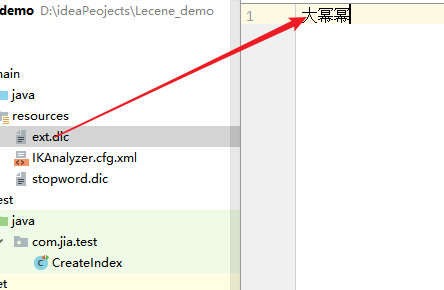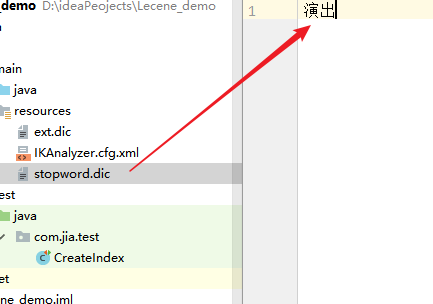Lucene入门
Lucene
倒排索引原理
Lucene的作用
Lucene创建索引基本API
Lucene查询基本API
了解搜索引擎
搜索引擎
什么是搜索引擎?
所谓搜索引擎,就是根据用户需求与一定算法,运用特定策略从互联网检索出制定信息反馈给用户的一门检索技术。搜索引擎依托于多种技术,如网络爬虫技术、检索排序技术、网页处理技术、大数据处理技术、自然语言处理技术等,为信息检索用户提供快速、高相关性的信息服务。搜索引擎技术的核心模块一般包括爬虫、索引、检索和排序等,同时可添加其他一系列辅助模块,以为用户创造更好的网络使用环境。
搜索引擎的原理
蜘蛛从索引区出发抓取网页,将抓取到的网页存放到临时库中进行处理(循环进行),把不符合规则的去除,符合规则的放到索引区,在索引区进行分类归档排序,最后将结果反馈给用户.
可以看到搜索引擎的功能主要是三部分:
爬行和抓取数据(爬虫多用Python来编写)
对数据做预处理(提取文字,中文分词、建立倒排索引)
提供搜索功能(用户输入关键词后,去索引库搜索数据)
数据库索引的问题
如果实现复杂类搜索,类似于百度,京东,使用传统数据库会存在一系列问题:
单表存储能力有限不能存储海量数据
可以进行分表,但会增加业务复杂度
搜索只能模糊匹配,效率极低
模糊搜索可能导致全表扫描,效率差
倒排索引
提高模糊搜索的效率
倒排索引是一种存储数据的方式,与传统查找有很大的区别:
传统查找:先找到文档,然后看是否匹配.采用数据按行存储,查找时逐行扫描,或者根据索引查找,然后匹配搜索条件,效率较差。
倒排索引:先找到词条,然后看看哪些文档包含这些词条。首先对文档数据按照id进行索引存储,然后对文档中的数据分词,记录对词条进行索引,并记录词条在文档中出现的位置。这样查找时只要找到了词条,就找到了对应的文档。
文档(Document):索引库中的每一条原始数据,例如一个网页信息,一件商品信息
词条:原始数据按照算法进行分词,得到的每一个词
创建倒排索引流程
创建倒排索引分两步:
创建文档列表(Document)
首先给每一条原始文档数据创建文档编号(docID),创建索引,形成文档列表
创建倒排索引列表
然后对文档中的数据进行分词,得到词条。对词条进行编号,并以词条创建索引。然后记录下包含该词条的所有文档编号(及其它信息)。
搜索流程
流程:
当用户输入任意的内容时,首先对用户输入的内容进行分词,得到用户要搜索的所有词条
然后拿着这些词条去倒排索引列表中进行匹配。找到这些词条就能找到包含这些词条的所有文档的编号。
然后根据这些编号去文档列表中找到文档
什么是Lucene
官网:http://lucene.apache.org/
Lucene是一套用于全文检索和搜寻的开源程序库,由Apache软件基金会支持和提供
全文检索:利用倒排索引技术对需要搜索的数据进行处理,然后提供快速的全文匹配的技术。
Lucene提供了一个简单却强大的应用程序接口(API),能够做全文索引和搜寻,在Java开发环境里Lucene是一个成熟的免费开放源代码工具
Lucene并不是现成的搜索引擎产品,但可以用来制作搜索引擎产品
Lucene的基本使用
Lucene对于索引的增(创建索引)、删(删除索引)、改(修改索引)、查(搜索数据)。
创建索引
基本流程

准备要添加的文档数据:Document
初始化索引写出工具:IndexWriter
设定索引存储目录Directory
设定其他配置:IndexWriterConfig
设定分词器:Analyzer
设定Lucene版本
写出索引
添加依赖
<dependencies> <!-- Junit单元测试 --> <dependency> <groupId>junit</groupId> <artifactId>junit</artifactId> <version>4.12</version> </dependency> <!-- lucene核心库 --> <dependency> <groupId>org.apache.lucene</groupId> <artifactId>lucene-core</artifactId> <version>4.10.2</version> </dependency> <!-- Lucene的查询解析器 --> <dependency> <groupId>org.apache.lucene</groupId> <artifactId>lucene-queryparser</artifactId> <version>4.10.2</version> </dependency> <!-- lucene的默认分词器库 --> <dependency> <groupId>org.apache.lucene</groupId> <artifactId>lucene-analyzers-common</artifactId> <version>4.10.2</version> </dependency> </dependencies> <build> <plugins> <plugin> <groupId>org.apache.maven.plugins</groupId> <artifactId>maven-compiler-plugin</artifactId> <configuration> <source>1.8</source> <target>1.8</target> <encoding>UTF-8</encoding> </configuration> </plugin> </plugins> </build>
代码实现
public class CreateIndex { @Test //创建索引 public void test1() throws IOException { //创建文档 Document document=new Document(); //name 字段名 //value 值 //store 是否存储 //StringField可以指定是否存储,但不能分词 document.add(new StringField("id","1", Field.Store.YES)); document.add(new TextField("title","大幂幂下乡演出Dance", Field.Store.YES)); //创建索引写出器 //创建目录对象 Directory dir= FSDirectory.open(new File("d:/lesson/indexDir")); //创建配置对象 IndexWriterConfig config=new IndexWriterConfig(Version.LATEST,new StandardAnalyzer()); IndexWriter indexWriter=new IndexWriter(dir,config); //添加文档到写出器(保存到索引库) indexWriter.addDocument(document); //提交,关流 indexWriter.commit(); indexWriter.close(); } }
可以利用索引查看工具查看目录
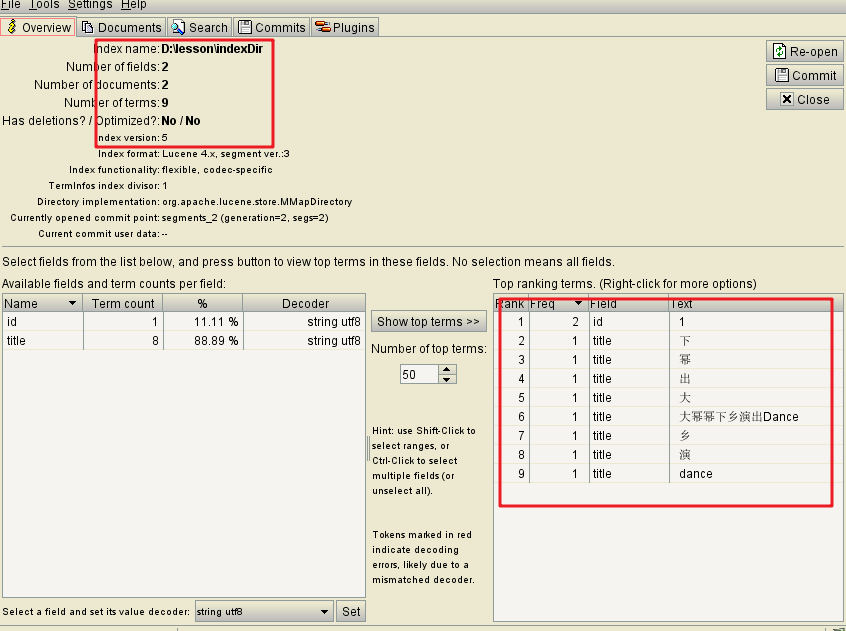
创建索引时的细节
创建索引时有一些细节API
覆盖或追加
我们在写索引时,可以在IndexConfigWriter中配置写入模式:覆盖或者追加:

可以有3种模式:
CREATE:每次写入都覆盖以前的数据
APPEND:不覆盖数据,而是使用以前的索引数据后追加
CREATE_OR_APPEND:如果不存在则创建新的,如果存在则追加数据
Field字段类型
刚才创建Document的时候,我们添加了两个字段,StringField和TextField,其实Field还有很多其它实现类:
DoubleField、FloatField、IntField、LongField、StringField、TextField这些子类创建的字段一定会被创建索引。但是不一定会被存储到文档列表,要通过构造函数中的参数Store来指定:
Store.YES代表存储,在搜索结果中也会展示出来
Store.NO代表不存储,在搜索结果中无法展示
这些字段虽然会创建索引,但是不一定会分词。不分词的字段,会作为一个整体词条存入索引,其中:
TextField即创建索引,又会被分词。其它Field会创建索引,但是不会被分词。
如果不分词,会造成整个字段作为一个词条,除非用户完全匹配,否则搜索不到。
我们一般,需要搜索的字段,都会做分词:
-上述所有字段都会创建索引,有一个例外:StoreField一定会被存储,但是一定不创建索引
StoredField可以创建各种数据类型的字段,一些不需要进行搜索的字段我们无需创建索引,就可以使用StoreField类型
这里最关键的是弄清楚一个字段:是否需要存储、是否需要索引、是否需要分词。弄清楚这个,就能知道怎么选择API了。
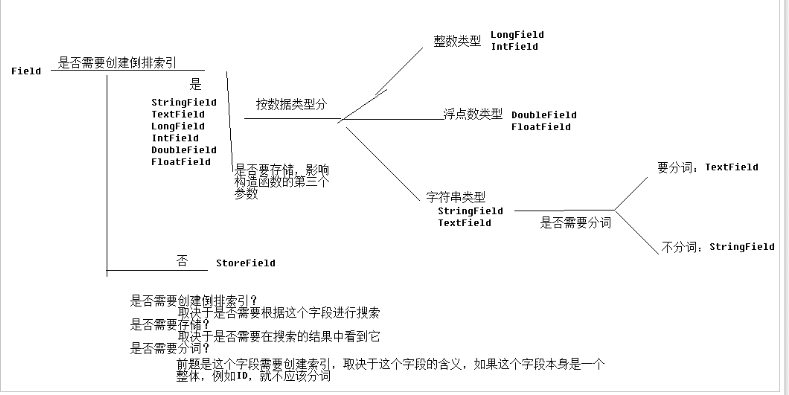
我们刚刚使用了StandardAnalyzer分词器,不过此分词器对中文的解析能力很差,我们需要中文分词器:
paoding,imdict,mmseg4j,ik
这里我们采用ik分词器
<dependency> <groupId>com.janeluo</groupId> <artifactId>ikanalyzer</artifactId> <version>2012_u6</version> </dependency>
修改代码

查看结果
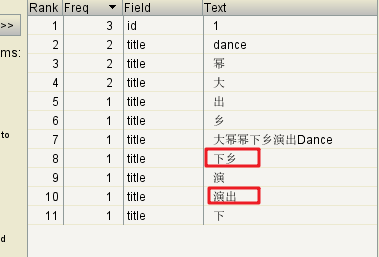
添加配置文件 IKAnalyzer.cfg.xml
<?xml version="1.0" encoding="UTF-8"?>
<!DOCTYPE properties SYSTEM "http://java.sun.com/dtd/properties.dtd">
<properties>
<comment>IK Analyzer 扩展配置</comment>
<!--用户可以在这里配置自己的扩展字典 -->
<entry key="ext_dict">ext.dic;</entry>
<!--用户可以在这里配置自己的扩展停止词字典 -->
<entry key="ext_stopwords">stopword.dic;</entry>
</properties>
查看结果
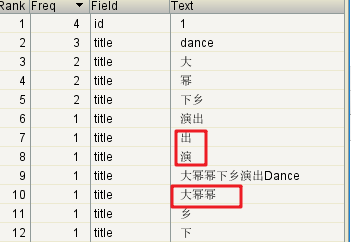
我们刚才使用IndexWriter中的addDocument方法来添加文档,然后写出到索引库,是一次添加一个文档。事实上这里也支持批量添加:

可以看到这个API接收的是一个Interable类型,即迭代器类型,完全可以接收一个集合
/** * 批量创建索引 */ @Test public void test2() throws IOException { // 创建文档的集合 Collection<Document> docs = new ArrayList<>(); // 创建文档对象 Document document1 = new Document(); document1.add(new StringField("id", "1", Field.Store.YES)); document1.add(new TextField("title", "大幂幂下乡演出Dance", Field.Store.YES)); docs.add(document1); // 创建文档对象 Document document2 = new Document(); document2.add(new StringField("id", "2", Field.Store.YES)); document2.add(new TextField("title", "大幂幂下乡表演了Dance", Field.Store.YES)); docs.add(document2); // 创建文档对象 Document document3 = new Document(); document3.add(new StringField("id", "3", Field.Store.YES)); document3.add(new TextField("title", "大幂幂下乡演唱Dance舞蹈", Store.YES)); docs.add(document3); // 创建文档对象 Document document4 = new Document(); document4.add(new StringField("id", "4", Field.Store.YES)); document4.add(new TextField("title", "大幂幂下乡演出Dance舞蹈看不下去了", Store.YES)); docs.add(document4); // 创建文档对象 Document document5 = new Document(); document5.add(new StringField("id", "5", Field.Store.YES)); document5.add(new TextField("title", "大幂幂下乡演出Dance人们都看不下去了", Store.YES)); docs.add(document5); // 索引目录类,指定索引在硬盘中的位置 Directory directory = FSDirectory.open(new File("d:\\lesson\\indexDir")); // 引入IK分词器 Analyzer analyzer = new IKAnalyzer(); // 索引写出工具的配置对象 IndexWriterConfig conf = new IndexWriterConfig(Version.LATEST, analyzer); // 设置打开方式:OpenMode.APPEND 会在索引库的基础上追加新索引。 // OpenMode.CREATE会先清空原来数据,再提交新的索引 conf.setOpenMode(IndexWriterConfig.OpenMode.CREATE); // 创建索引的工具类。参数:索引的目录和配置信息 IndexWriter indexWriter = new IndexWriter(directory, conf); // 把文档集合交给IndexWriter indexWriter.addDocuments(docs); // 提交 indexWriter.commit(); // 关闭 indexWriter.close(); } }
索引的基本查询
基本流程
创建索引搜索工具
指定索引目录
创建读取流工具
创建搜索工具
创建查询条件
创建查询解析器
解析用户搜索语句,得到查询条件对象
搜索并解析结果
代码如下
public class QueryIndex {
@Test
//基本查询
public void test1() throws Exception {
//1.创建索引搜索工具
//- 指定索引目录
Directory directory= FSDirectory.open(new File("d:\\lesson\\indexDir"));
//- 创建读取流工具
IndexReader reader= DirectoryReader.open(directory);
//- 创建搜索工具
IndexSearcher indexSearcher=new IndexSearcher(reader);
//2.创建查询条件
//- 创建查询解析器
QueryParser parser=new QueryParser("title", new IKAnalyzer());
//- 解析用户搜索语句,得到查询条件对象
Query query = parser.parse("大幂幂");
//3.搜索并解析结果
TopDocs topDocs = indexSearcher.search(query, 10);//每次查询几条
System.out.println("共查询到"+topDocs.totalHits+"条文档");
System.out.println("最高分数"+topDocs.getMaxScore());
ScoreDoc[] scoreDocs = topDocs.scoreDocs;
for (ScoreDoc scoreDoc : scoreDocs) {
System.out.println("得分"+scoreDoc.score);
int doc = scoreDoc.doc;
Document document = reader.document(doc);
System.out.println(document.get("id"));
System.out.println(document.get("title"));
}
}
}
结果:
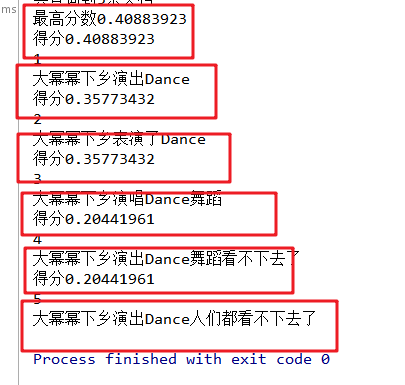
索引的高级查询
在刚才的基本查询中,我们使用QueryParser来解析并获取查询条件对象Query。事实上,Query有很多的子类,代表各种不同的特殊查询方式:
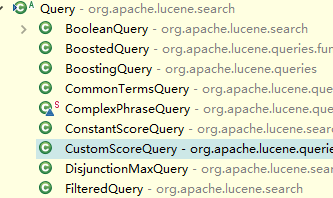
抽取通用查询方法
当我们使用各种不同查询时,其它代码几乎不动,就是查询条件在发生变化,因此我们可以把查询代码进行抽取
public class QueryIndex { @Test //基本查询 public void test1() throws Exception { //2.创建查询条件 //- 创建查询解析器 QueryParser parser=new QueryParser("title", new IKAnalyzer()); //- 解析用户搜索语句,得到查询条件对象 Query query = parser.parse("大幂幂"); search(query); } private void search(Query query) throws IOException { //1.创建索引搜索工具 //- 指定索引目录 Directory directory= FSDirectory.open(new File("d:\\lesson\\indexDir")); //- 创建读取流工具 IndexReader reader= DirectoryReader.open(directory); //- 创建搜索工具 IndexSearcher indexSearcher=new IndexSearcher(reader); //3.搜索并解析结果 TopDocs topDocs = indexSearcher.search(query, 10);//每次查询几条 System.out.println("共查询到"+topDocs.totalHits+"条文档"); System.out.println("最高分数"+topDocs.getMaxScore()); ScoreDoc[] scoreDocs = topDocs.scoreDocs; for (ScoreDoc scoreDoc : scoreDocs) { System.out.println("得分"+scoreDoc.score); int doc = scoreDoc.doc; Document document = reader.document(doc); System.out.println(document.get("id")); System.out.println(document.get("title")); } } }
词条查询
词条,英文是Term,代表对原始数据进行分词后得到的每一个词语。是搜索匹配时的最小单位,不可再分词。
因此词条查询必须是精确匹配查询。用户输入的查询条件必须是完整的词条。
增加方法如下: @Test public void termQuery() throws IOException { //词条查询 Query query=new TermQuery(new Term("title","表演")); search(query); }
//模糊查询 @Test public void testFuzzyQuery() throws IOException { //创建模糊查询对象:允许用户输错。但是要求错误的最大编辑距离不能超过2 // 编辑距离:一个单词到另一个单词最少要修改的次数 danca --> dance 需要编辑1次,编辑距离就是1 //FuzzyQuery query = new FuzzyQuery(new Term("title", "Denca")); //可以手动指定编辑距离,但是参数必须在0~2之间 FuzzyQuery query = new FuzzyQuery(new Term("title", "Danca"),2); search(query); }
数值范围查询
把批量创建索引的StringField改成LongField,然后测试
/* * 测试:数值范围查询 * 注意:数值范围查询,可以用来对非String类型的ID进行精确的查找 */ @Test public void testNumericRangeQuery() throws Exception{ // 数值范围查询对象,参数:字段名称,最小值、最大值、是否包含最小值、是否包含最大值 Query query = NumericRangeQuery.newLongRange("id", 2L, 2L, true, true); search(query); }
修改索引
基本流程
创建索引写出对象
指定目录
配置
创建文档
更新数据
/**
* 注意,这里的更新接收的条件时Term,即词条。需要注意两点:
* 1)搜索条件最好唯一,例如ID,否则后果很严重
* 2)之前说过,词条要求必须是字符串类型,那如果我们的id是Long类型怎么办?
* @throws Exception
*/
@Test
public void testUpdate() throws Exception{
// 创建目录对象
Directory directory = FSDirectory.open(new File("d:\\lesson\\indexDir"));
// 创建配置对象
IndexWriterConfig conf = new IndexWriterConfig(Version.LATEST, new IKAnalyzer());
// 创建索引写出工具
IndexWriter writer = new IndexWriter(directory, conf);
// 创建新的文档数据
Document doc = new Document();
doc.add(new StringField("id","1", Field.Store.YES));
doc.add(new TextField("title","小幂幂下乡表演sing", Field.Store.YES));
/* 修改索引。参数:
* 词条:根据这个词条匹配到的所有文档都会被修改
* 文档信息:要修改的新的文档数据
*/
writer.updateDocument(new Term("id","1"), doc);
// 提交
writer.commit();
// 关闭
writer.close();
}
删除索引
创建索引写出工具
创建删除条件
删除
/** * 删除的方式有多样: * 1)根据Term删除,需要注意: * a. 词条的数据类型必须是字符串 * b. 最好根据id进行唯一匹配删除,如果id不是字符串类型怎么办? * 2)根据Query删除 * @throws Exception */ @Test public void testDelete() throws Exception { // 创建目录对象 Directory directory = FSDirectory.open(new File("d:\\lesson\\indexDir")); // 创建配置对象 IndexWriterConfig conf = new IndexWriterConfig(Version.LATEST, new IKAnalyzer()); // 创建索引写出工具 IndexWriter writer = new IndexWriter(directory, conf); // 根据词条进行删除 // writer.deleteDocuments(new Term("id", "1")); // 根据query对象删除,如果ID是数值类型,那么我们可以用数值范围查询锁定一个具体的ID // Query query = NumericRangeQuery.newLongRange("id", 2L, 2L, true, true); // writer.deleteDocuments(query); // 删除所有 writer.deleteAll(); // 提交 writer.commit(); // 关闭 writer.close(); } }




